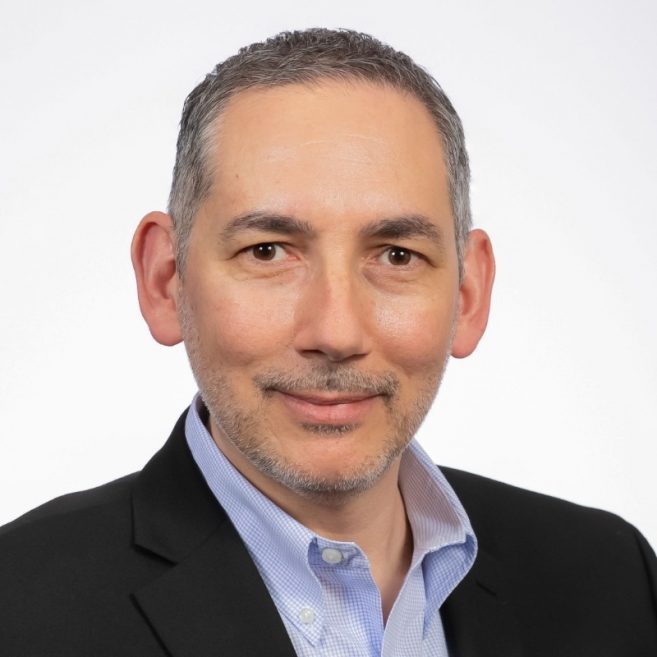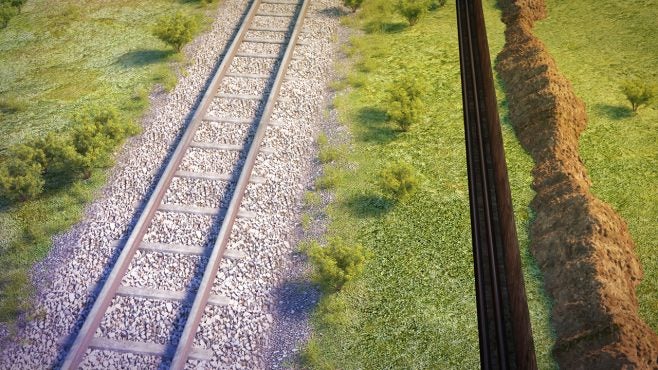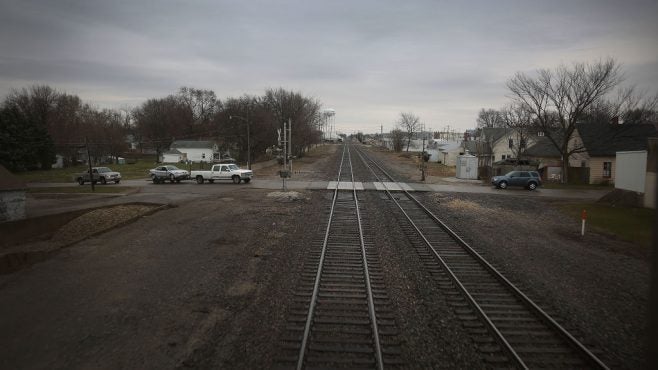Building transmission infrastructure in the US is one of the most vexing energy transition challenges. Landowners often balk at granting developers access to their property for overhead transmission lines and towers. Large projects can take a decade or more to complete – if they break ground at all.
SOO Green HVDC Link is a project being advanced by Minneapolis-based transmission developer Direct Connect Development Company. It believes it has developed a model to build transmission at the scale required to decarbonise the grid, while avoiding many of the obstacles that have scuppered other projects. Instead of stringing wires between massive overhead towers, SOO Green wants to bury high-voltage direct current (HVDC) cables underground along an existing railroad corridor running between the US states of Iowa and Illinois.
The 350-mile, 2,100MW, $2.5bn privately financed project is backed by Copenhagen Infrastructure Partners, Siemens Energy and Jingoli Power. SOO Green aims to connect the US’s Midwest and East Coast power markets and deliver abundant Great Plains wind power to the grid. The project could spur more than 4,000MW of new renewable energy development in the upper Midwest, says SOO Green vice-president Steve Frenkel.
In conversation with Energy Monitor, Frenkel explains why SOO Green is a “template to follow nationally”.

How do you pitch the SOO Green HVDC Link?
SOO Green is a first-of-its-kind, transformative infrastructure project that will establish the first link in a national clean energy grid. We are creating a model for inter-regional transmission infrastructure development that avoids many of the problems that have prevented these kinds of projects from proceeding in the past. By innovating our underground installation model along existing railroads, we avoid battles over permitting and siting and over who pays for transmission lines.
This underground rail co-location approach cuts the development cycle in half compared with traditional overhead greenfield transmission development. Because our model is replicable and fast compared with traditional methods of developing overhead transmission lines, we think we have a model to build a national clean energy grid.
The US has tremendous untapped renewable energy resources across the Great Plains in the Midwest that cannot be delivered to market today because there is no path to connect those resources to the customers who need that clean power. SOO Green will provide that path to connect the Midwest power markets to power markets in the east.
If you want more renewables, you need more transmission. We as a nation will not realise our clean energy potential unless we invest in transmission infrastructure.

Can this model be replicated along other rights of way like interstate highways?
We were really heartened to see in President Biden’s American Jobs Plan that he called for private capital to be deployed to deliver affordable renewable energy along existing transportation corridors, roads and rails. SOO Green is the flagship project that achieves Present Biden’s vision. If we can demonstrate the success of SOO Green, we have a template to follow nationally.
The railroads we have been talking to see a lot of promise in this approach to leverage their existing rights of way. They have already done this successfully for many years with fibre-optic installations along existing rails. SOO Green has proven that HVDC cables can be safely installed underground, are fully compatible with safe railroad operations and do not interfere with railroads.
The line will be passively installed, adjacent to the rail, just like fibre-optic has been installed on existing railroad corridors. The advantage of railroads is that you know your route from point A to point B from day one. It avoids having to secure a project route from hundreds if not thousands of individual landowners. That kind of problem has thwarted overhead high-voltage projects that have faced opposition from thousands of landowners.
Interstate highways can be a very viable approach. There is the possible challenge of having to navigate more jurisdictional ownership, whether it is a county road or a state highway, whereas ownership of sections of rail tends to be longer distance and perhaps simpler.
Can you flesh out the comparison between your model and the one used to build fibre-optic cable networks?
Just like fibre-optic cable presents an additional revenue stream for railroads, the underground installation of high-voltage direct current cable presents a new revenue opportunity for railroads to leverage their existing rights of way. They are starting to see that is attractive.
SOO Green recently filed a complaint with the Federal Energy Regulatory Commission [FERC] objecting to delays in the approval process required to connect to the PJM grid. Why is SOO Green unhappy with PJM’s interconnection process?
We have been experiencing ongoing delays from PJM [the regional transmission organisation that coordinates the movement of wholesale electricity in much of the eastern US] in completing the technical studies needed to enable us to connect to the grid. These delays and the uncertainty associated with them are delaying the project and creating unnecessary risk and uncertainty.
When deploying $2.5bn of private capital, it is critical that project developers and the investors who stand behind them have as much certainty as possible. The level of uncertainty associated with PJM’s interconnection process is unjust and unreasonable. We have asked FERC to intervene and provide relief to the project.
[Keep up with Energy Monitor: Subscribe to our weekly newsletter]
Under PJM’s existing rules, a privately financed merchant transmission project like SOO Green is required to complete the generation interconnection process along with hundreds of generation projects. Even though we are a transmission project, we are lumped in with generators that are also seeking to connect to the grid. PJM has been inundated with so many requests from renewable energy projects in its territory that want to connect to the grid that it has created significant delays.
It is ironic because the very renewable energy projects that would like to connect to the grid are delayed because there is insufficient transmission capacity. It will take PJM longer to study SOO Green than it will take us to build a $2.5bn, 350-mile-long project. We do not think that makes sense.
Legislation recently introduced in the US Congress aims to boost transmission construction. It includes a proposal by Senator Martin Heinrich for a federal 30% investment tax credit (ITC) for transmission. What policies would make it easier to build projects?
We are very supportive of Congress adopting a new investment tax credit that would support major transmission infrastructure projects like SOO Green. A federal ITC could do for transmission what similar tax credits have done for renewable energy. It would transform the marketplace and create the momentum and certainty market needs.
We have been strongly supportive of Senator Heinrich's proposal and President Biden's American Jobs Plan, which also calls for adopting an ITC for transmission. That would help support projects like SOO Green and others to enable the delivery of affordable, renewable energy to where it is needed, attract private capital and create thousands of good-paying union jobs from coast to coast.
What is the project timeline going forward?
Our hope is that with a favourable ruling by FERC we can expedite the project schedule by several months. Right now, our expectation is that we would begin construction in 2023 and begin commercial operations in 2026. We are taking all appropriate steps to compress that timeframe by seeking a remedy from FERC, and other avenues.
How does SOO Green compare on cost on a per-mile basis with overhead transmission lines?
There has been a persistent myth in the industry that underground installation is more expensive. Perhaps that was true years ago, but it is no longer the case. With advances in state-of-the-art HVDC cable technology, we can achieve economies of scale that were not possible until recently, and that has allowed projects like SOO Green to be on cost parity with traditional overhead, high-voltage projects, whether AC or DC.
Cost parity is best explained by talking about costs on a per-megawatt-mile basis, not just per megawatt or per mile. Dollars per mile ignores the capacity of the line to deliver energy and does not factor in the volume of energy that is being delivered. Dollars per megawatt mile captures the length of the project and the volume of electricity being delivered. On a dollars-per-megawatt-mile basis, SOO Green is on par or more cost effective than traditional overhead projects.

How do you mollify stakeholders, landowners and neighbours who might resist a large new transmission project?
The SOO Green model is a landowner-friendly, farm-friendly, and environmentally friendly approach to developing large-scale transmission infrastructure. By installing transmission lines underground, entirely within an existing railroad corridor, we avoid the need to intrude on private property to secure the project route. We avoid the environmental impacts of building large overhead towers, and we avoid the visual impacts neighbours and property owners often dislike about traditional transmission projects.
With SOO Green's project on the Iowa side of the line we have had under a dozen objections out of 2,500 adjacent landowners. There were well over 1,000 objectors to projects that preceded us that were attempting to build across the state of Iowa going overhead. We have virtually no landowner opposition to this project and have had very positive interactions and relationships with adjacent landowners across the entire route. We think this demonstrates the success of the model.



